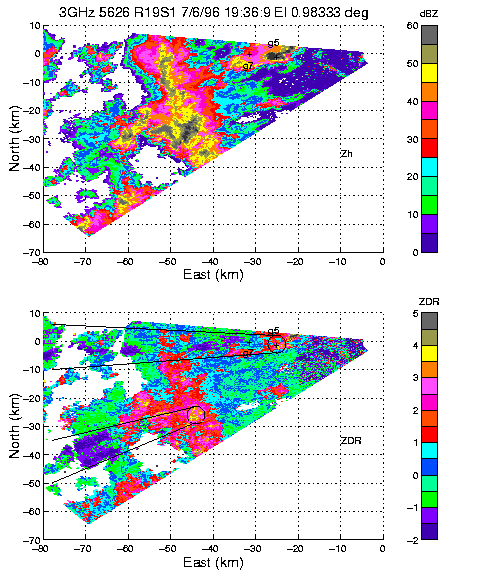











Last update
5 Apr 2001

This page is maintained by
Mark Fielding
All content Copyright © The University of Reading unless otherwise stated.
Polarisation algorithms to correct for attenuation at C-band
Chun-Lei Liu and Anthony J. IllingworthThe problem
- Attenuation is a severe problem at C-band
- C-band used operationally in Europe and Japan
- Gate-by-gate correction of Z is notoriously unstable
- Attenuation is not uniquely related to differential phase shift
Simulations by Bringi et al (1990) suggested attuation is related to differential phase shift, but they did not consider Values of median diameter D0 above 2.5mm (ZDR>3dB). Most attenuation events have higher ZDR (Smyth and Illingworth, QJ, 1998 p2398).
Non-polarisation technique solution
- UK Met. Office currently use empirical 2-way correction at
C-band (Gunn and East 1954):
A = 0.0044 R1.17 dB/km at 18°C (1) - It is based on exponential drop spectra with the drop shape of sphere. Gate-by-gate correction can blow up, so the correction is capped at 3 dB.
- New rain size-spectrum analysis: raindrop spectra are best
represented by normalised gamma functions
 (2)
(2)where D0 is the diameter that splits the volume of water in two equal parts. Fitting to spectra by forcing the third, fourth and sixth moments to equal the appropriately weighted integral of the gamma function show that NL is close to 8000 m3mm-1 (Marshall-Palmer value) and mu is about five. this leads to a relationship of the form:
Av = 0.00258 R1.23 dB/km at 0°C (3a)
Av = 0.00124 R1.31 dB/km at 20°C (3b)
- This is about 50% of the value predicted by Equation 1 (Gunn and East); e.g. for 100mm/hr, the Gunn and East formula predicts 1 dB/km wherease the new gamma functions predict 0.5 dB/km.

Predicted C-band attenuation for horizontal and vertical polarisation at 0°C and 20°C for a normalised gamma function with mu=5 and NL = 8000 m-3mm-1.
Conclusion: recommend (3b) used operationally in the UK, not (1)
Polarisation technique solution
- At S-band, simulations by Bringi et al (1990), in which
D0 was limited to 2.5 mm, suggested the attenuation could
be derived from differential phase shift (KDP). This leads to
Total attenuation Ah = 0.016 KDP dB/°
Differential attenuation Ah-Av = 0.00367 KDP dB/° - but D0 = 2.5 mm is a ZDR of only 3 dB; most attenuation events have higher ZDR values (i.e. large raindrops)
- If we extend simulations up to D0 = 3.5 mm we find
the unique relationship breaks down and we can't derive attenuation
from differential phase shift (KDP).
- Observations of differential attenuation and differential phase
shift confirm there is no simple relationship between the two. A plot
of observed negative ZDR against total differential phase
suggests
- Attenuation higher than Bringi et al.
- Highest values of all when ZDR > 5 dB (bold points)
- Ryzhkov and Zrnic (1994) also found differential attenuation higher than Bringi et al. and invoked half melted ice cores, but this can be explained simply by high-ZDR rain.

Example of negative
ZDR at S-band behind intense rain cells (high Z and
ZDR). Gauge 5 was recording a rain rate of 267
mm/hr.

Observed values of total
differential phase shift, phiDP.
Total differential attenuation, Ah-Av, observed
behind intense echoes with the s-band chilbolton radar. Bold points
correspond to rays with ZDR above 5 dB
Simple solution at C-band
- At C-band, it turns out that differential attenuation is
linearly related to total attenuation. so we can estimate total
attenuation from the negative ZDR behind the heavy rain.

Predicted variation of Ah versus Ah-Av at C-band for NL = 8000 m-3mm-1 at 0°C and 20°C for mu = 0 and 5. The dashed line is for NL = 40000 m-3mm-1. - The problem with using KDP to correct for attenuation
is that KDP depends on the real part of the forward scatter
amplitude, and attenuation to the imaginary part; these have different
behaviour with size and temperature.
- However, differential and total attenuation both depend on the imaginary part of the scatter amplitude, so
Recommend use of negative ZDR behind heavy rain to
estimate total attenuation.
Would work for UKMO C-band radars if
radars had dual polarisation.